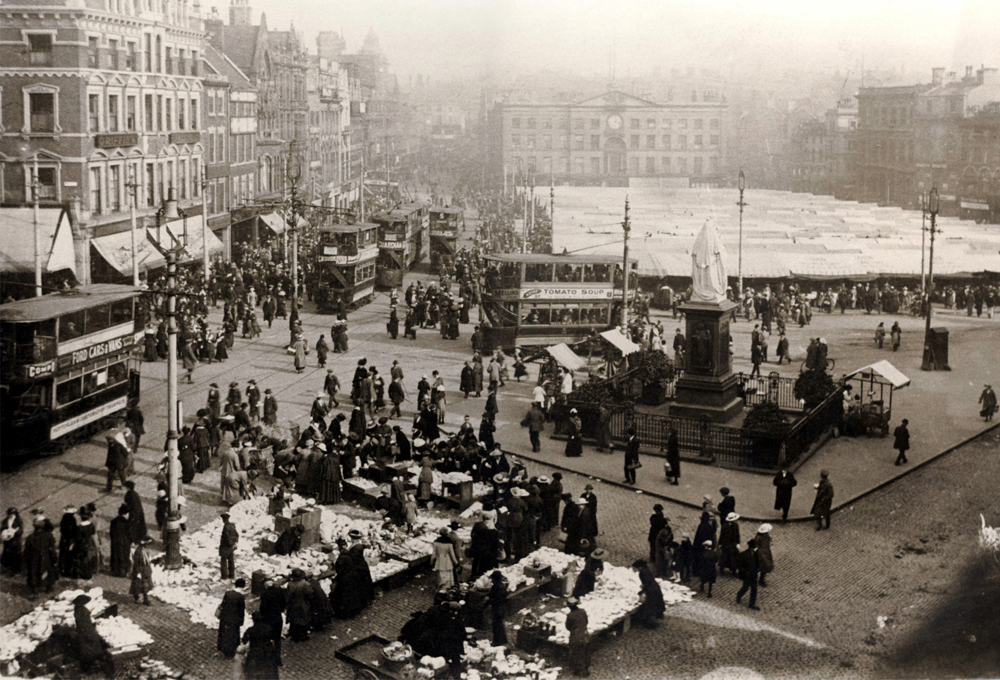Nottingham
The name Snotengaham was first recorded in the late ninth century, but the 'S' was dropped in the twelfth century. This Anglo Saxon name meant 'homestead of the people of Snot'.

County: Nottinghamshire
Population (2001): 267,000
The location of Nottingham provided early settlers with a connection to the coast via the river Trent and also a point at which it was possible to ford the Trent. An early settlement was located on the banks of the river Leen in an area subject to regular flooding. This was soon relocated to an area of higher ground.
The Danes arrived in Nottingham in the late ninth century and established a fortified settlement. The protection offered by an earth bank around the town was increased by the addition of a timber rampart. The defences did not stop the town from falling back into the hands of the Anglo Saxons in 920. Nottingham prospered during the tenth century and a mint was established there.
In 1067 the Normans built Nottingham's first castle on high ground to the west of the early settlement. The initial structure was of timber and was replaced in the twelfth century with a stone-built castle. The two halves of the town operated independently of each other, with the original eastern district known as the English borough and the castle area referred to as the French borough.
During the medieval period Nottingham established itself as a trading centre for the area. Charters granted rights to the town and weekly markets and annual fairs were held. Wool production and processing became the main industry in the town at this time. The population of the town expanded from around 1,500 in 1066 to 3,000 in the fourteenth century.
The availability of wool in the town and local development of the knitting frame stimulated a knitting industry to develop in the seventeenth century. The industry continued to expand in the following century. Framework knitters experimented with new knitted fabrics and developed early forms of lace. Workshops and warehouses clustered in what became known as the Lace Market.
By the beginning of the nineteenth century Nottingham's population had reached 28,000. New houses that were built across the town provided living accommodation for residents, but also placed a strain on the infrastructure. The town suffered a cholera epidemic in 1833. Civic amenities continued to improve during the century with the introduction of gas lighting, a police force, the railway, a public library, parks and recreation grounds.
The town's annual Goose Fair changed from being a market selling the wares of farmers and tradesmen to an event with fairground rides and sideshows. In 1877 Wombwell's Menagerie of 20 monster carriages, 57 great cart horses and 7,000 birds and animals visited the Fair. Visitors in 1892 were able to view Professor England's 'Royal Exhibition of Performing Fleas'.
The knitting industry continued to play an important role in Victorian Nottingham. Firms such as I. & R. Morley and Allen & Solly prospered and employed many Nottingham residents. Other famous Nottingham firms also emerged during the Victorian era. Jesse Boot took his father's herbal remedy shop and turned it into a chemist selling cut-price treatments. The business was established as Boot and Company Limited in 1883. Elsewhere in Nottingham a small firm on Raleigh Street produced cycles. In 1887 Sir Frank Bowden, after receiving advice from his doctor, bought a cycle from the factory and was impressed with his purchase. Sir Frank returned to the factory a few months later and bought a share of the business. The Raleigh Cycle Company (taking its name from Raleigh Street) was founded in 1888 and by 1896 the business had gone from producing three cycles a week to owning the largest cycle factory in the world.
Nottingham ended the nineteenth century by being made a city in 1897. In 1928 the city was granted the right to appoint a Lord Mayor. The following year a new council house opened on Market Square. Twentieth century Nottingham continued to expand in size and population. In common with other local cities, new houses were built across the city, including many council houses. In the 1950s and 1960s estates were added in Bilborough and Clifton.
Modern Nottingham has developed as a popular shopping and tourist destination. The Broadmarsh and Victoria shopping centres opened in the 1970s to provide large areas of covered shopping facilities. The city's link with Robin Hood and the infamous Sheriff of Nottingham still attracts thousands of visitors from across the world each year. Many visit the Castle Museum & Art Gallery, Brewhouse Yard Museum and the Costume Museum.
Brewhouse Yard
The Museum of Nottingham Life is now housed at Brewhouse Yard.